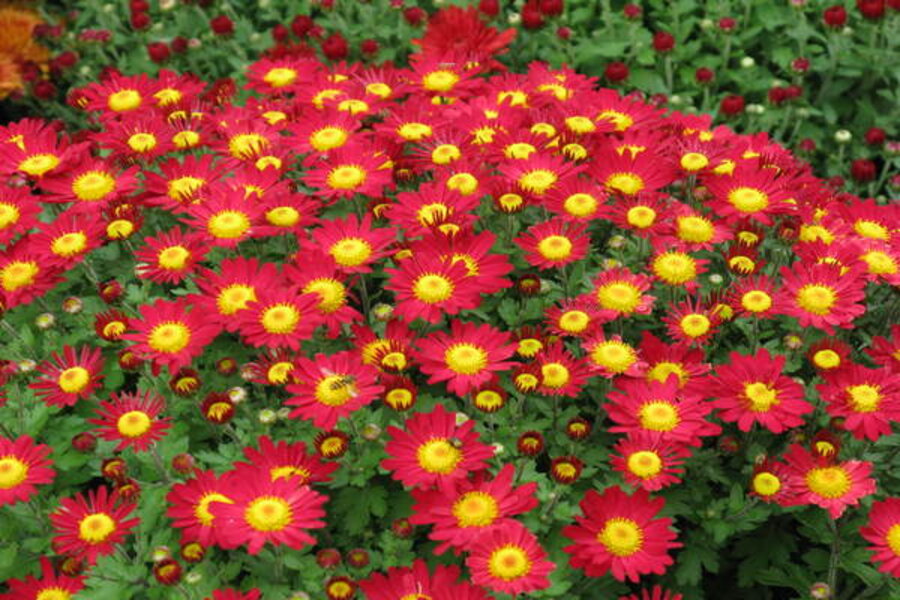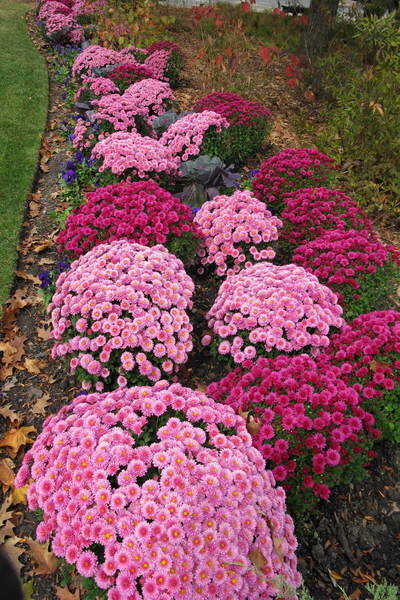A lifelong love of mums
Loading...
I love chrysanthemums!
Chrysanthemums – or mums, as most of us refer to them – are the quintessential fall favorites, both in beds and borders and as cut flowers.
Hawked by every corner grocery store, supermarket, big box store, garden center, nursery, and farmers' market, they are best known for firing up fall with their incredible color.
Planted by the gazillions from single plants popped into containers adorning our porches, balconies, and front steps to the numerous varied or intricate displays at industrial parks, city parks, and botanical gardens, mums are, nevertheless, reviled by many.
During one of those rare moments of introspection that come sometimes when one reaches a certain age, I realize that I’ve spent many memorable and fun moments of my life in the company of mums.
The mums of childhood
In my own gardens, I never thought of my gangly plants as some horticulturally exotic friends, but rather more as constant companions -- warm and fuzzy remnants of my childhood.
I remember clearly those overcast, crisp October days when as a mere child I trailed behind my mom or grandmother as they strode about their garden ablaze in vivid gold, bright purple, pale lavender, creamy white, butter yellow, and bold red mums stuck in odd places, hither and yon, throughout their small yard.
I would lug a bucket nearly as big as I was – or so it felt at the time – filled with a few inches of water to hold the precious blooms of the dozens upon dozens of stems of the bright, bold beauties they cut off right before the oncoming frosts. Later, back in the house, hours were spent in creating dreamy arrangements full of multi-hued color with these vivid blooms that decorated the house for weeks.
Choosing mums
Mums are classified by their flower forms, which are just as varied as their colors.
Daisy types resemble their namesake; delicate and lacy spiders have those long, tightly curved petals with hooked tips so popular in Oriental art; and spoons look just like your imagination dictates – rolled petals that are flattened at the tips.
Decorative types have overlapping petals, or rays, that either curve upward (incurve) creating a round ball or bend downward (reflex) and look something like a flattened ball. The pompons (not pompoms), have a globe-shaped head with short petals, of which the smaller varieties are called buttons.
Neighbors in the old Chicago neighborhood where I grew up each had their specialty.
My grandma adored the spoons, while my mom stuck with the more traditional decorative types. The elderly gentleman two houses down had the greatest collection of spiders, while the genteel lady on the corner hovered over her large incurve mums like a mother hen over her chicks.
Blossoms were shared, and there were always vases in our house filled with the neighbors’ prized offerings.
During my college days, mums were synonymous with football games. Coeds (gee, do we even use this term anymore?) pinned on giant yellow or white “football” mums (our corner lady’s incurve bloomers) primped with the school’s initials emblazed in blue and orange pipe cleaners smushed in the center of the blossom.
Later, after I got married, I carried cuttings of these mums into my own gardens. Unfortunately, my mums never received any compliments for they were gangly, wind-whipped hulks with blossoms way too small for their height. I had never given them the love and attention bestowed by my elders.
Mums, like children, need boundaries. And hardy mums have a few unique growing quirks. To grow stocky, heavy-flowering plants, pinching back the growing tips several times in spring and early summer is essential.
I never did – for lack of time or inclination, I really can’t say. At the very least, I should have staked them and pinched off most of the buds from the lowest section of the stems. To my discredit, I never did this, either.
Still, they have survived, if not thrived, under my care.
As years passed, commercial growers introduced new varieties of mums that soon became the darlings of the floral industry. Regal and bright, they were bred to retain their good looks and color longer than other potted plants.
Thus, all of my friends and neighbors who had babies, were hospitalized or incapacitated for any reason or invited us for evenings filled with merriment and sumptuous food wound up with my ubiquitous offering – potted mums.
And Monet, one of my favorite painters, didn’t stop with waterlilies, either; he also painted glorious pots of mums.
So yes, to this day I buy those potted cushion mums in full autumn flower so readily available everywhere for some immediate gratification. I treat them as annuals, enjoying their fiery colors now, and remembering them fondly when they are gone.
But come next spring, I intend to revisit my old friends in my garden, lovingly divide them, pinch them back a few times, and hope they’ll keep my garden colorful – and my memories vivid and bright – for seasons to come.
Growing instructions for Northern and Southern gardens
For excellent instructions on how to grow chrysanthemums in the North, see the article “Growing Chrysanthemums” by the Ohio State University Extension.
For Southern regions, see “Chrysanthemum” at Clemson Cooperative Extension.
-----
Betty Earl, the Intrepid Gardener, blogs regularly at Diggin' It. She's the author of “In Search of Great Plants: The Insider’s Guide to the Best Plants in the Midwest.” She also writes a regular column for Chicagoland Gardening Magazine and The Kankakee Journal and numerous articles for Small Gardens Magazine, American Nurseryman, Nature’s Garden, and Midwest Living Magazine, as well as other national magazines. She is a garden scout for Better Homes and Gardens and a regional representative for The Garden Conservancy. To read more by Betty, click here.








